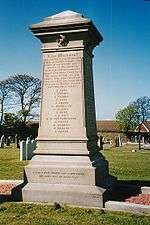SS Rohilla
The steamship Rohilla grounded off the coast of England, 1914 | |
| History | |
|---|---|
| Name: | Rohilla |
| Owner: | British India Steam Navigation Co Ltd, London |
| Port of registry: | Glasgow |
| Route: |
|
| Builder: | Harland and Wolff, Belfast |
| Yard number: | 381 |
| Launched: | 6 September 1906 |
| Completed: | 16 November 1906 |
| Identification: | Official number: 124149 |
| Fate: | On 30 October 1914, struck a reef at Saltwick, near Whitby, and sank. |
| Notes: | [1] |
| General characteristics | |
| Type: | Passenger ship/troopship, later hospital ship |
| Tonnage: | |
| Length: | 460.1 ft (140.2 m) |
| Beam: | 56.0 ft (17.1 m) |
| Draught: | 28.3 ft (8.6 m) |
| Installed power: | 8,000 ihp (6,000 kW) |
| Propulsion: | Twin Harland & Wolff quadruple expansion steam engines |
| Speed: | 16.6 knots (30.7 km/h; 19.1 mph) |
| Capacity: | 167 passengers; later c.1,600 troops |
| Notes: | |
Rohilla was a passenger steamer of the British India Steam Navigation Company which was built for service between the UK and India, and as a troopship. After becoming a hospital ship in the First World War, Rohilla ran aground in October 1914 near Whitby with the loss of 83 lives.
History
Rohilla was ordered in 1905 by the British India Steam Navigation Company (BI) from Harland & Wolff Ltd of Belfast, at the same time as sister ship Rewa from William Denny & Bros at Dumbarton. They differed mainly in their engines: Rewa was triple-screw with steam turbines, while Rohilla had a pair of quadruple expansion steam engines, also made by Harland & Wolff, and twin screws. Rohilla's engines totalled 8,000 indicated horsepower (6,000 kW), producing 16.6 knots (30.7 km/h; 19.1 mph) on sea trials. Although ordered for the London to Calcutta service, increased competition prompted BI to design the two sisters to be suitable also as troopships.[1]
The steamship was named Rohilla in honour of the Rohillas, Pashtun highlanders who lived in Rohilkhand, east of Delhi, in the modern Indian state of Uttar Pradesh.[1]
After entering service, the sisters were soon taken up for trooping, in 1908 for Rohilla as 'Troopship No.6'. Two years later they were the first BI ships to have radio receivers fitted, and were both hired in that year for the Coronation Fleet Review, carrying members of the House of Lords (Rewa) and House of Commons (Rohilla).[1]
Loss
Rohilla was called up at the outset of the First World War and converted into a naval hospital ship.[1] HMHS (His Majesty's Hospital Ship) Rohilla had only a short life in that role. On 30 October 1914, sailing from South Queensferry, Firth of Forth for Dunkerque to evacuate wounded soldiers, the ship ran aground on Saltwick Nab, a reef about a mile east of Whitby, North Riding of Yorkshire, during a full south westerly gale and with the lighthouses unlit due to the war. The reef is about 400 yards (370 m) offshore and the ship soon broke her back.[1][2]
The conditions made rescue extremely difficult, but lifeboats from Whitby, Upgang (near Whitby), Redcar, Tynemouth and Scarborough attempted to close on the wreck.[2][3] Over the next three days, some of those who attempted to swim to safety in the raging seas were rescued, though many were lost, and lifeboats were able to rescue others.[4] In all, 146 of the 229 on board, including Captain Neilson and all the nurses, as well as Titanic survivor Mary Kezia Roberts, survived.[2][5][6][7]
Captain Nielson believed that the ship had struck a mine before grounding.[8] An inquest jury exonerated Nielson from all blame and recommended that all passenger vessels carry rocket apparatus rather than rely on rockets fired to the ship from shore, and also that a motor lifeboat be stationed at Whitby.[8]
The Gold Medal of the Royal National Lifeboat Institution, the highest honour the institute could award, was presented to Superintendent Major H. E. Burton and Coxswain Robert Smith of the Tynemouth lifeboat Henry Vernon and to Coxswain Thomas Langlands of the Whitby lifeboat. The Empire Gallantry Medal (subsequently changed to the George Cross) was awarded to Burton and Smith in 1924.[9][10] In 1917 a monument was erected at Whitby by the British India Steam Navigation Company, commemorating all those who lost their lives in the tragedy.[11]

See also
References
- 1 2 3 4 5 6 7 Laxon, W A (Bill); Perry, F W (Fred) (1994). B I: The British India Steam Navigation Company Limited. Kendal: World Ship Society. pp. 100–101, 245. ISBN 0-905617-65-7.
- 1 2 3 Hocking, Charles (1969). Dictionary of Disasters at Sea During the Age of Steam: Vol II. London: Lloyd's Register of Shipping. p. 594.
- ↑ BBC: Coast, Series 7
- ↑ "The Rohilla Wreck". Shields Daily News. 2 November 1914. Retrieved 30 July 2014.
- ↑ "Titanic Survivors". Encyclopedia Titanica. Retrieved 29 July 2014.
- ↑ "The Wrecked Hospital Ship". The Times. London. 1 November 1914. p. 1.
- ↑ "Hospital Ship Wreck". The Times. London. 2 November 1914. p. 3.
- 1 2 "The Rohilla Mined". The Times. London. 6 November 1914. p. 5.
- ↑ "Lifeboat-men's Gallantry, Court Circular". The Times. London. 1 July 1924. pp. 13 & 19.
- ↑ "Memorial to a Lifeboat Hero". The Times. London. 6 June 1928. p. 21.
- ↑ "A 'Rohilla' Monument at Whitby". Craven Herald. 15 June 1917. Archived from the original on 30 July 2014. Retrieved 30 July 2014.
Further reading
- Brittain, Colin (2002). Into the Maelstrom: The Wreck of HMHS Rohilla. The History Press. ISBN 0-7524-2384-3
- HMS Rohilla photograph at Port Said(archived)